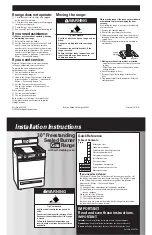
TYPICAL CABINET INSTALLATION
•
Location – Check location where the range will be installed. Check for proper electrical and gas supply, and the stability of
the floor.
•
Dimensions that are shown must be used. Given dimensions provide minimum clearance. Contact surface must be solid
and level.
Follow all dimension requirements provided bellow to prevent property damage, potential fire hazard, and incorrect
countertop and cabinet cuts.
•
Make sure the cabinets and wall covering around the range can withstand temperatures (up to 200°F) generated by
the range.
•
30” minimum clearance between cooking surface and bottom of unprotected wood or metal cabinet
•
24” minimum clearance when bottom of wood or metal cabinet is protected by not less than ¼” flame retardant
millboard covered with not less than No. 28 MSG sheet steel, 0.015” stainless steel, 0.024” aluminum or 0.020” copper
•
18” minimum clearance upper cabinet to countertop.
•
To reduce the risk of burns or fire when reaching over hot surface elements, cabinet storage space above the cook-top
should be avoided. If cabinet storage space is to be provided above the cook-top, the risk can be reduced by installing
a range hood that sticks out at least 5” beyond the front of the cabinets. Cabinets installed above a cook-top must be
no deeper than 13”.
•
1” minimum to wall on either side of range above 36” height.
Provide Proper Fuel Type
Before Proceeding:
Your range is preset to operate on natural gas only. All models are shipped with convertible with parts
and conversion instructions.
CAUTION:
DO NOT
attempt to convert this range to LP/Propane settings without the proper LP/Propane conversion kit
provided with the range. Follow all instructions provided with the conversion kit.
Important Notes:
TO INSTALLER:
•
Read all instructions contained in these installation instructions before installing range.
•
Remove all packing material from the oven compartments before connecting the gas and electrical supply to the range.
•
Observe all governing codes and ordinances.
•
Leave installation instructions with homeowner.
•
Proper installation is the responsibility of the installer.
TO HOMEOWNER:
•
Keep installation instructions for future reference.











































